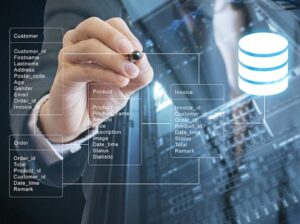In the dynamic landscape of data-driven decision-making, businesses are turning to the transformative power of AI graph databases to unlock unparalleled insights. This cutting-edge technology is reshaping the way organizations harness and analyze interconnected data, paving the way for more informed, strategic, and agile business strategies.
In the first part of this blog series, we discussed the concept of AI graph databases and how artificial intelligence is transforming databases. Moreover, you will learn about the challenges of graph databases and how AI helps you address those challenges.


So far if you have already gained the basic insights of AI graph databases, then surely, you would like to discover how it will empower your business and its use cases.
Let’s get into the details of each point.
Here are the key highlights:
- How do AI graph databases empower and benefit businesses?
- Enhanced query performance
- Dynamic schema adaptation
- Intelligent data discovery
- Use cases and applications of AI graph databases
- What’s the future of AI graph databases and how do they handle complex data structures?
Let’s get the answers below.
How Do AI Graph Databases Empower and Benefit Businesses?
AI graph databases represent a powerful tool for businesses, offering a range of benefits that significantly impact their data management and analytical capabilities. Let’s delve into three key aspects that highlight how AI graph databases empower businesses:
1. Enhanced Query Performance
Enhanced query performance is a pivotal feature of AI graph databases, optimizing the way businesses interact with and retrieve information. In traditional databases, complex queries involving interconnected data points can be time-consuming.
AI graph databases, however, utilize advanced algorithms to streamline these queries, significantly reducing response times.
Benefits for Businesses:
- Real-time decision-making: Faster query responses enable businesses to make decisions in real time, a crucial capability in scenarios where timely insights are paramount.
- Improved user experience: Whether it’s an end-user querying a database or an application retrieving data, enhanced query performance ensures a smoother and more responsive experience.
How Does It Work?
Consider an online retail platform. With enhanced query performance in an AI graph database, the platform can quickly analyze user behavior, preferences, and inventory status to provide personalized product recommendations in real time. This not only enhances the user experience but also increases the likelihood of successful transactions.
2. Dynamic Schema Adaptation
Dynamic schema adaptation is the ability of AI graph databases to evolve and adjust to changes in data structures without the need for complex migrations or disruptions.
Unlike traditional databases with fixed schemas, AI graph databases can dynamically incorporate new data attributes, relationships, or types, providing unparalleled flexibility.
Benefits for Businesses:
- Agility and innovation: Businesses can quickly adapt their data structures to changing requirements, fostering agility and supporting innovation.
- Reduced downtime: Dynamic schema adaptation minimizes downtime associated with structural changes, ensuring continuous operation even during updates.
How Does It Work?
Let’s take an e-commerce platform expanding its product offerings to include new categories. With dynamic schema adaptation, the AI graph database seamlessly incorporates these changes, allowing the platform to scale its offerings without interrupting ongoing operations.
3. Intelligent Data Discovery
Intelligent data discovery involves leveraging AI capabilities to uncover hidden patterns, relationships, and insights within interconnected data. AI graph databases employ machine learning algorithms to analyze the complex web of relationships, revealing valuable information that might go unnoticed in traditional databases.
Benefits for Businesses
- Informed decision-making: Businesses gain a deeper understanding of relationships and trends, supporting more informed and strategic decision-making.
- Competitive advantage: Uncovering unique insights provides a competitive edge, enabling businesses to stay ahead in their industry.
How Does It Work?
Consider a financial institution managing customer transactions. Intelligent data discovery in an AI graph database can reveal patterns of fraudulent activity by analyzing the relationships between transaction nodes, assisting the institution in proactively identifying and preventing fraudulent behavior.
Use Cases and Applications of AI Graph Databases
Conducting detailed market research, we found some of the top industries that have successfully implemented AI graph databases. In addition, reports have shown the positive results of how AI graph databases have helped them bring great change.
Healthcare: Predictive Patient Care
A leading hospital utilized AI graph databases to map patient data, identifying relationships between symptoms, treatments, and outcomes.
Utilizing the predictive analytics-enabled personalized care plans, they have noticed a great reduction in readmission rates by 20%.
Finance: Fraud Detection
A financial institution integrated AI graph databases to analyze transaction data and detect fraudulent patterns within interconnected networks.
With the usage of AI graph databases, fraud detection accuracy increased by 25%, resulting in a substantial reduction in financial losses.
E-commerce: Personalized Marketing
An e-commerce giant implemented AI graph databases to analyze customer interactions and relationships between products.
The impact of AI graph databases on personalized marketing campaigns led to a 15% increase in conversion rates.
What’s the Future of AI Graph Databases?
The future of AI graph databases holds exciting prospects, driven by technological advancements, growing adoption, and the evolving needs of industries.
Here are some key aspects that highlight the potential future of AI graph databases:
Advanced Machine Learning Integration
The integration of more advanced machine learning capabilities into AI graph databases will enable predictive modeling and analysis, allowing businesses to anticipate trends and make proactive decisions.
Graph Neural Networks (GNNs)
The rise of graph neural networks will enhance the learning capabilities of AI graph databases, enabling them to understand complex patterns and dependencies in interconnected data more effectively.
Edge Computing and Decentralized Applications
The future of AI graph databases involves increased compatibility with edge computing, allowing for real-time analysis and decision-making on the edge. This aligns with the growing trend of decentralized applications.
Industry-Specific Solutions
AI graph databases will see a surge in industry-specific solutions, tailored to address the unique challenges and requirements of sectors such as healthcare, finance, logistics, and more.
Integration with Blockchain
Integration with blockchain technology will likely increase, providing enhanced security, transparency, and immutability of interconnected data, making it especially valuable for applications like supply chain management and financial transactions.
Autonomous Systems and IoT
As the Internet of Things (IoT) continues to grow, AI graph databases will play a vital role in managing and analyzing the intricate relationships between IoT devices, contributing to the development of more autonomous systems.
Natural Language Processing (NLP) Integration
Integration with advanced natural language processing will make AI graph databases more accessible, allowing users to interact with databases using natural language queries.
Hybrid and Multi-Cloud Deployments
The future involves the rise of hybrid and multi-cloud deployments, enabling businesses to harness the scalability and flexibility of AI graph databases across various cloud environments.
Ethical and Responsible AI
As AI technologies, including graph databases, continue to evolve, there will be an increased focus on ethical considerations and responsible AI practices, ensuring the fair and transparent use of interconnected data.
Democratization of Graph Database Technology
The accessibility of AI graph database technology will likely increase, with efforts focused on democratizing access and making these advanced tools available to a broader range of businesses, regardless of size.
The future of AI graph databases is dynamic and adaptive, shaped by ongoing technological advancements and the diverse needs of businesses. As these databases become more ingrained in various industries, their transformative impact on data management and analysis is expected to grow significantly.
Conclusion
In the exciting realm of data management, AI graph databases are ushering in a transformative era. Unlike traditional databases, these intelligent systems excel in understanding complex relationships within interconnected data.
The power of AI enhances their adaptability, making them dynamic entities capable of evolving alongside changing data patterns. From personalized healthcare to fraud detection in finance, the applications span various industries, promising operational efficiency and informed decision-making.
- SEO Powered Content & PR Distribution. Get Amplified Today.
- PlatoData.Network Vertical Generative Ai. Empower Yourself. Access Here.
- PlatoAiStream. Web3 Intelligence. Knowledge Amplified. Access Here.
- PlatoESG. Carbon, CleanTech, Energy, Environment, Solar, Waste Management. Access Here.
- PlatoHealth. Biotech and Clinical Trials Intelligence. Access Here.
- Source: https://www.dataversity.net/how-ai-graph-databases-are-empowering-the-business-with-better-insights-part-two/
- :is
- :not
- :where
- 1
- 15%
- a
- ability
- About
- access
- accessibility
- accessible
- across
- activity
- Ad
- adapt
- adaptation
- adaptive
- addition
- address
- adjust
- Adoption
- advanced
- advancements
- ADvantage
- agile
- ahead
- AI
- algorithms
- Aligns
- Allowing
- alongside
- already
- also
- an
- analysis
- Analytical
- analyze
- analyzing
- and
- answers
- anticipate
- Application
- applications
- ARE
- artificial
- artificial intelligence
- AS
- aspects
- assisting
- associated
- attributes
- autonomous
- autonomous systems
- available
- basic
- BE
- become
- behavior
- below
- benefit
- benefits
- Better
- between
- blockchain
- blockchain technology
- Blog
- bring
- broader
- business
- businesses
- but
- by
- CAN
- capabilities
- capability
- capable
- care
- cases
- categories
- chain
- challenges
- change
- Changes
- changing
- Cloud
- compatibility
- competitive
- complex
- computing
- concept
- considerations
- continue
- continues
- continuous
- contributing
- Conversion
- crucial
- customer
- cutting-edge
- data
- data management
- data points
- data-driven
- Database
- databases
- DATAVERSITY
- decentralized
- Decentralized Applications
- Decision Making
- decisions
- deeper
- delve
- Democratizing
- dependencies
- deployments
- detailed
- details
- detect
- Detection
- Development
- Devices
- discover
- discovery
- discussed
- disruptions
- diverse
- do
- does
- downtime
- driven
- during
- dynamic
- dynamically
- e-commerce
- each
- Edge
- edge computing
- effectively
- efficiency
- efforts
- empower
- empowering
- enable
- enabling
- enhance
- enhanced
- Enhances
- ensures
- ensuring
- entities
- environments
- Era
- especially
- Ether (ETH)
- ethical
- Even
- Event
- evolve
- evolving
- Excel
- exciting
- expanding
- expected
- experience
- fair
- far
- Feature
- finance
- financial
- financial institution
- fixed
- Flexibility
- Focus
- focused
- For
- fostering
- found
- fraud
- fraud detection
- fraudulent
- fraudulent activity
- from
- future
- Future of AI
- Gain
- gained
- get
- giant
- Go
- graph
- graph neural networks
- great
- Grow
- Growing
- handle
- harness
- Have
- healthcare
- helped
- helps
- Hidden
- Highlight
- highlights
- holds
- Hospital
- How
- However
- HTTPS
- Hybrid
- identifying
- if
- immutability
- Impact
- implemented
- in
- include
- Including
- incorporate
- incorporates
- Increase
- increased
- Increases
- industries
- industry
- industry-specific
- information
- informed
- ingrained
- Innovation
- insights
- Institution
- integrated
- integration
- Intelligence
- Intelligent
- interact
- interactions
- interconnected
- Internet
- internet of things
- into
- intricate
- inventory
- involves
- involving
- iot
- iot devices
- IT
- ITS
- Key
- landscape
- language
- leading
- LEARN
- learning
- leveraging
- like
- likelihood
- likely
- logistics
- losses
- machine
- machine learning
- make
- Making
- management
- managing
- map
- Market
- market research
- Marketing
- might
- minimizes
- modeling
- more
- Moreover
- Natural
- Natural Language
- Natural Language Processing
- Need
- needs
- networks
- Neural
- neural networks
- New
- NIH
- nlp
- nodes
- of
- offering
- Offerings
- on
- ongoing
- online
- online retail
- only
- operation
- operational
- Operations
- optimizing
- or
- organizations
- Orlando
- outcomes
- Paramount
- part
- patient
- patient data
- patterns
- Paving
- performance
- Personalized
- pivotal
- plans
- platform
- plato
- Plato Data Intelligence
- PlatoData
- Play
- Point
- points
- positive
- potential
- power
- powerful
- practices
- predictive
- preferences
- preventing
- Proactive
- processing
- Product
- product offerings
- Products
- promising
- prospects
- provide
- provides
- providing
- queries
- quickly
- range
- Rates
- real
- real-time
- realm
- recommendations
- reducing
- reduction
- Regardless
- Relationships
- Reports
- represent
- Requirements
- research
- reshaping
- response
- responses
- responsible
- responsive
- resulting
- Results
- retail
- reveal
- revealing
- Rise
- Role
- Scalability
- Scale
- scenarios
- seamlessly
- Sectors
- security
- see
- Series
- shaped
- shown
- significantly
- Size
- smoother
- Solutions
- some
- span
- Status
- stay
- Strategic
- strategies
- streamline
- structural
- structures
- substantial
- successful
- Successfully
- such
- supply
- supply chain
- supply chain management
- Supporting
- surely
- surge
- Symptoms
- Systems
- tailored
- Take
- technological
- Technologies
- Technology
- that
- The
- The Future
- their
- Them
- then
- There.
- These
- they
- things
- this
- those
- three
- time
- time-consuming
- timely
- times
- to
- tool
- tools
- top
- traditional
- transaction
- Transactions
- transformative
- transforming
- Transparency
- transparent
- treatments
- Trend
- Trends
- Turning
- two
- types
- uncover
- understand
- understanding
- unique
- unlike
- unlock
- unparalleled
- Updates
- Usage
- use
- User
- User Experience
- users
- ushering
- using
- utilize
- utilized
- Valuable
- Valuable Information
- various
- viewed
- vital
- Way..
- we
- web
- whether
- will
- with
- within
- without
- Work
- would
- you
- Your
- zephyrnet












